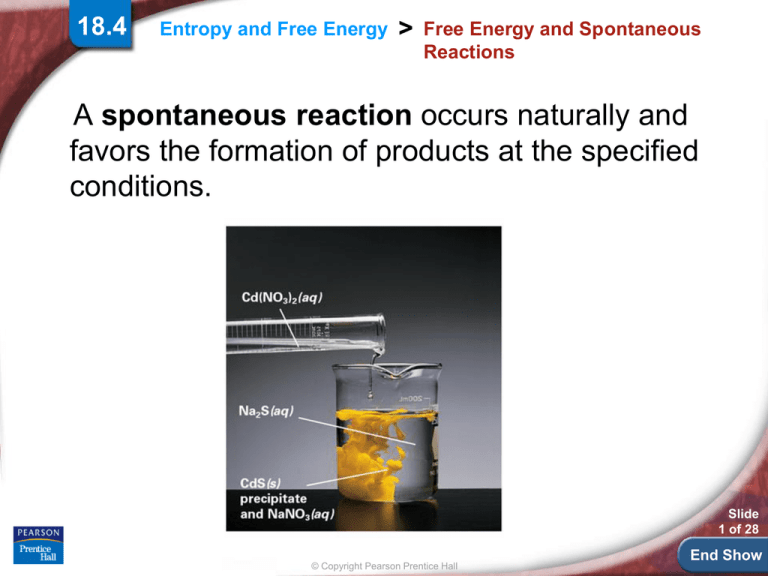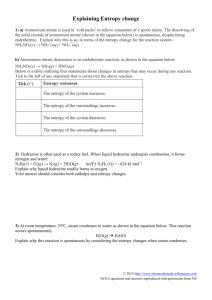
18.4
Entropy and Free Energy
>
Free Energy and Spontaneous
Reactions
A spontaneous reaction occurs naturally and
favors the formation of products at the specified
conditions.
Slide
1 of 28
© Copyright Pearson Prentice Hall
End Show
18.4
Entropy and Free Energy
>
Free Energy and Spontaneous
Reactions
A nonspontaneous reaction is a reaction that
does not favor the formation of products at the
specified conditions.
Photosynthesis is a
nonspontaneous
reaction that requires
an input of energy.
Slide
2 of 28
© Copyright Pearson Prentice Hall
End Show
18.4
Entropy and Free Energy
>
Free Energy and Spontaneous
Reactions
Spontaneous reactions produce
substantial amounts of products at
equilibrium and release free energy.
Gibb’s free energy/free energy is energy that is
available to do work and is represented by the
symbols ΔG; it is calculated from the ΔH (change
in enthalpy; heat of reaction), temperature (T in
kelvin) and ΔS (change in entropy) for the
reaction.
What part does entropy play Slide
3 of 28
in chemical reactions?
© Copyright Pearson Prentice Hall
End Show
18.4
Entropy and Free Energy
>
Entropy
Entropy is a measure of the disorder of a
system.
• Physical and chemical systems attain the
lowest possible energy.
• The law of disorder states that the natural
tendency is for systems to move in the
direction of maximum disorder or
randomness.
• An increase in entropy favors the
spontaneous chemical reaction; a decrease
favors the nonspontaneous reaction.
© Copyright Pearson Prentice Hall
Slide
4 of 28
End Show
18.4
Entropy and Free Energy
>
Entropy
For a given substance, the entropy of the gas is
greater than the entropy of the liquid or the solid.
Similarly, the entropy of the liquid is greater than
that of the solid.
Slide
5 of 28
© Copyright Pearson Prentice Hall
End Show
18.4
Entropy and Free Energy
>
Entropy
Entropy increases when a substance is divided
into parts.
Slide
6 of 28
© Copyright Pearson Prentice Hall
End Show
18.4
Entropy and Free Energy
>
Entropy
Entropy tends to increase in chemical reactions in
which the total number of product molecules is
greater than the total number of reactant
molecules.
Slide
7 of 28
© Copyright Pearson Prentice Hall
End Show
18.4
Entropy and Free Energy
>
Entropy
Entropy tends to increase when temperature
increases. As the temperature increases, the
molecules move faster and faster, which
increases the disorder.
Slide
8 of 28
© Copyright Pearson Prentice Hall
End Show
18.4
Entropy and Free Energy
>
Enthalpy, Entropy, and Free Energy
Enthalpy, Entropy, and Free Energy
What two factors determine the
spontaneity of a reaction?
The size and direction of enthalpy
changes and entropy changes together
determine whether a reaction is
spontaneous; that is, whether it favors
products and releases free energy.
© Copyright Pearson Prentice Hall
Slide
9 of 28
End Show
18.4
Entropy and Free Energy
>
Enthalpy, Entropy, and Free Energy
The numerical value of ΔG is negative in spontaneous
processes because the system loses free energy.
© Copyright Pearson Prentice Hall
Slide
10 of 28
End Show
18.4 Section Quiz.
Assess students’ understanding
of the concepts in Section 18.4
Continue to:
-or-
Launch:
Section Quiz
Slide
11 of 28
© Copyright Pearson Prentice Hall
End Show
18.4 Section Quiz.
1. Free energy from a reaction is the amount of
energy that is
a. absorbed by an entropy decrease.
b. equal to the enthalpy change.
c. wasted as heat.
d. available to do work.
Slide
12 of 28
© Copyright Pearson Prentice Hall
End Show
18.4 Section Quiz.
2. Free energy is always available from
reactions that are
a. endothermic.
b. nonspontaneous.
c. at equilibrium.
d. spontaneous.
Slide
13 of 28
© Copyright Pearson Prentice Hall
End Show
18.4 Section Quiz.
3. Choose the correct words for the spaces:
Spontaneous reactions produce ________
and substantial amounts of _________ at
equilibrium.
a. free energy, products
b. no free energy, reactants
c. free energy, reactants
d. no free energy, products
Slide
14 of 28
© Copyright Pearson Prentice Hall
End Show
18.4 Section Quiz.
4. Which of the following involves a decrease in
entropy?
a. Natural gas burns.
b. A liquid freezes.
c. Dry ice sublimes.
d. Water evaporates.
Slide
15 of 28
© Copyright Pearson Prentice Hall
End Show
18.4 Section Quiz.
5. A reaction is spontaneous if
a. enthalpy decreases and entropy increases.
b. enthalpy increases and entropy increases.
c. enthalpy decreases and entropy
decreases.
d. enthalpy increases and entropy decreases.
Slide
16 of 28
© Copyright Pearson Prentice Hall
End Show








